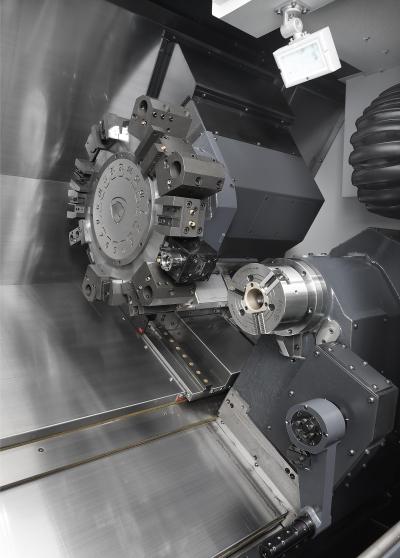
Doosan Machine Tools introduces the Lynx 2600SY, the latest generation in the popular Lynx series of compact turning centers with a Y-axis. The new machine incorporates all the design features of the popular Lynx 2100LSYB, but is built on a slightly bigger platform.
Customer feedback played a large role in the development of the new model. The Lynx 2600SY was designed to provide maximum flexibility and versatility for job shops that want to handle a wider range of projects without stepping up in size to a PUMA Series boxway machine.
The Lynx 2600SY is designed with a rigid bed structure and incorporates roller type LM guides for all axes. The maximum turning diameter is 14.9” and the maximum turning length is 24”, and the main spindle incorporates a 10” chuck while the sub-spindle handles either a 6- or 8-inch chuck size. The main spindle has a speed of 3,500 r/min (25HP) while the sub-spindle turns at 4,500 r/min (15HP), making quick work of complex parts. The Y-axis travel is 4.13”, and a 12 station servo-driven BMT tool turret with a half index feature (24 positions) is standard.
A new feature on the Lynx 2600SY is the latest controller from FANUC, the 0i-TF Plus, which is available with optional iHMI user interface, specifically designed by FANUC for ease of use. The 0i-TF Plus features 3D part views that will offer more detail, which are easily viewable on the new 15" touch screen (previously 10"). The control is equipped with the Doosan EZ guide conversational programming feature, but doesn't take away the traditional G-code programming language.
Contact Details
Related Glossary Terms
- G-code programming
G-code programming
Programs written to operate NC machines with control systems that comply with the ANSI/EIA RS-274-D-1980 Standard. A program consists of a series of data blocks, each of which is treated as a unit by the controller and contains enough information for a complete command to be carried out by the machine.
- centers
centers
Cone-shaped pins that support a workpiece by one or two ends during machining. The centers fit into holes drilled in the workpiece ends. Centers that turn with the workpiece are called “live” centers; those that do not are called “dead” centers.
- chuck
chuck
Workholding device that affixes to a mill, lathe or drill-press spindle. It holds a tool or workpiece by one end, allowing it to be rotated. May also be fitted to the machine table to hold a workpiece. Two or more adjustable jaws actually hold the tool or part. May be actuated manually, pneumatically, hydraulically or electrically. See collet.
- conversational programming
conversational programming
Method for using plain English to produce G-code file without knowing G-code in order to program CNC machines.
- turning
turning
Workpiece is held in a chuck, mounted on a face plate or secured between centers and rotated while a cutting tool, normally a single-point tool, is fed into it along its periphery or across its end or face. Takes the form of straight turning (cutting along the periphery of the workpiece); taper turning (creating a taper); step turning (turning different-size diameters on the same work); chamfering (beveling an edge or shoulder); facing (cutting on an end); turning threads (usually external but can be internal); roughing (high-volume metal removal); and finishing (final light cuts). Performed on lathes, turning centers, chucking machines, automatic screw machines and similar machines.
